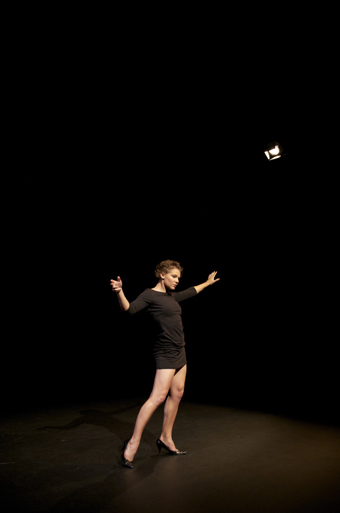look out below
keith gallasch: invisible forces, aurora music festival

Miranda Wheen, Quest
photo Heleana Genaus icantakephotos.com
Miranda Wheen, Quest
THE FORCES THAT INHIBIT OR EXAGGERATE OUR BEHAVIOUR ARE NOT ALWAYS VISIBLE TO US, VEILED AS THEY ARE BY IDEOLOGIES OR DRIVEN BY THE UNCONSCIOUS OR OUR GENES. IN QUEST, A WOMAN (MIRANDA WHEEN) ATTEMPTING TO MOVE SYMMETRICALLY THROUGH A BARE WORLD APPEARS TO BE CONTROLLED BY FORCES FROM WITHIN—INVOLUNTARY CONSTRAINTS AND EXCESSES.
These might be external, but are not revealed to be so—no literal miming here—and are more likely to be internalised. Initially we see her from behind, black high heels, hair slicked, tight short little black dress. She might have stepped straight out of a Robert Palmer music video or Robert Longo’s 1980s Men in the Cities series. But her apparent confidence and sexiness is about to be undone. Her shoulders tense emphatically. She walks slowly towards us on a circular trajectory, an arm reaching out, leading her as she goes in small turns, both arms now extended.
She looks back at us, her centre of gravity off-centre but remaining strangely stable as she leans or is pushed back almost impossibly far in a near floating gyration. The quietly evolving, plangent music builds to rich glissandi and deep foghorn-ish notes on viola and saxophone. More of the body comes into play, or is played as the dancer leans deeply to the side, knees lowered, the music aptly more angular, until she finds herself on the floor—at two points only, toes and hands, held as if trapped. Her arms lift her, her feet drag, the saxophone rumbling empathetically. But standing, her arms and legs now move discretely, one leg shoots out on its own, the sway of the body seems to push her up, her journey tumbles into totterings. A shoe is lost, prelude to dissolution which takes her to the floor, spinning wildly like a frantic insect. Stop. She stands. She takes control. She starts again.
The considerable demands of Martin del Amo’s choreography are met with unflinching commitment by Miranda Wheen who manages to combine exquisite precision with a very open, engaging performativity. Alex Pozniak’s fine score, played onstage by Andrew Smith on saxophone and Luke Spicer on viola, melds beautifully with the choreography, subtly underlining the physical exertions on the dance with a certain melancholy, even in its most dramatic, but never overly so, moments.
To witness such a determined struggle with invisible forces was exhilarating, a reminder of the ways our bodies are buffeted by new experiences whether erupting from within or battering us from without. Let’s hope Quest will be seen again—it’s a fine addition to each artist’s repertoire, not least Wheen, fast being revealed to be one of Sydney’s most accomplished dance artists.
Daniel Blinkhorn’s frostbYte cHatTer offers a more material interiority, the sound of arctic ice in its sonic straining and cracking dance and its mutation into water. In near dark and surround sound, the ice crunches, slides and squeals about us on an epic scale, like an imagined shift of tectonic plates, realised by the composer/sound designer’s use of microphones in the open and hydrophone recordings of “icebergs and iceberg fragments as they melt, collide and dissolve” (program note).
Blinkhorn takes these sounds, and others of a sailing ship in another piece, sustains their essential character but also composes them into sometimes quite musical creations building on the icebergs’ ceaseless and increasing chatter as they draw near each other. The sounds are fascinatingly multifarious although when heard at some length after having witnessed an already exacting dance work, there were times when I was thinking of ice cracking as not unlike paint drying. And then I’d be snapped out of it by some seismic shift. To do justice to the works in Blinkhorn’s program I’d most certainly need to have more than another listen—there’s a lot going on: an honouring of composer Luc Ferrari, the deployment of prepared piano and the use of sources that include field recordings made on coral reefs in Australia and the West Indies.
A closer connection with Quest was to be found in frostbYte—cReEpEr, “produced by some of the frenetic actions and (sometimes bizarre) gestures produced whilst walking on ice” with microphone in one hand. The struggle to maintain balance nicely matches Quest’s involuntarism, and it even dances, if for far too long (such is the idiom), by slipping into found sound-based electronica.
Aurora Festival of Living Music: Invisible Forces, Quest, choreographer Martin del Amo, composer Alex Pozniak, dancer Miranda Wheen, musicians Luke Spicer, Andrew Smith; frostbYte cHatTer, sound artist & composer Daniel Blinkhorn; Campbelltown Arts Centre, Sydney, May 12; www.auroranewmusic.com.au/
RealTime issue #109 June-July 2012 pg. web






